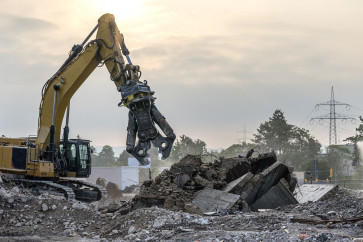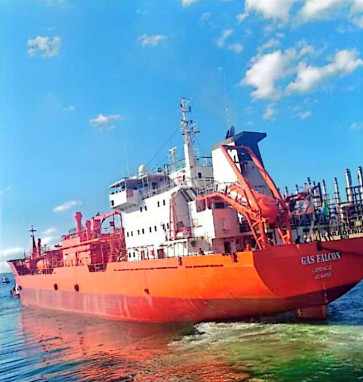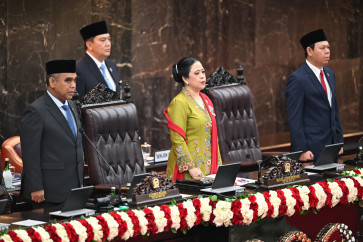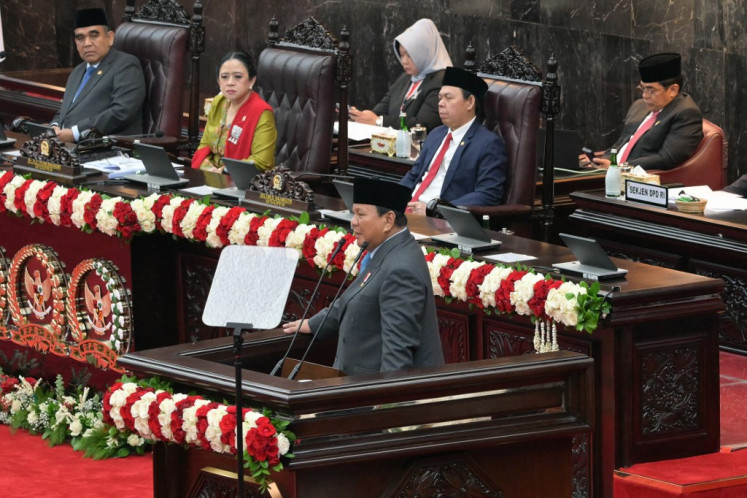Popular Reads
Top Results
Can't find what you're looking for?
View all search resultsPopular Reads
Top Results
Can't find what you're looking for?
View all search resultsRobbing Demak to pay Semarang: Flood controls make erosion worse
Land lost: A resident of Sriwulan village in Demak regency, Central Java, stares at a spot where the foundations of a house were inundated with seawater as a result of high rates of coastal erosion
Change text size
Gift Premium Articles
to Anyone
L
and lost: A resident of Sriwulan village in Demak regency, Central Java, stares at a spot where the foundations of a house were inundated with seawater as a result of high rates of coastal erosion. Many houses in Demak’s coastal villages are threatened by the environmental problem.(JP/Donny Fernando)
Water used to be the first sight to greet train passengers arriving into Tawang Station in Semarang, Central Java, between the mid-1990s and late-2000s, when the station and other buildings in the northern part of the provincial capital used to be inundated almost daily by tidal floods, known locally as the rob.
As a coastal city, Semarang’s most pressing concerns are usually about seawater. In recent years, the impact of floods has worsened as a result of rising sea levels, coastal erosion and land subsidence.
Both the central government and regional administration have made efforts to tackle the problem. The city administration has joined hands with several companies to build polders — a flood-control system using dikes — in the Banger River to stop recurring tidal floods inundating Semarang’s northern coast. Apart from the polders, the authorities are also building a sea wall and other concrete-based structures to prevent the rob from flooding the city.
In the meantime, the government has also been constructing other facilities on the city’s northern coast to support the region’s economy, including reclaiming land for the Terboyo industrial complex and Tanjung Mas Port.
All this construction on the northern coast of Semarang, however, has come at a cost that unfortunately is borne by the city’s closest neighbor, Demak regency.
“When Semarang is done with its tidal floods, it will later impact us in Demak. Coastal erosion occurring in our area might be influenced by projects there,” Saiful Muhammad Arif, 32, a resident of Bedono village in Demak told The Jakarta Post recently.
Erosion is a natural phenomenon in coastal ecosystems where the land is abraded by, among other forces, waves and tides. In ideal conditions a similar amount of land is created by the deposition of sediment in a process called accretion.
However, such a balance is not occurring in Demak and other coastal areas across the country.
The Maritime Affairs and Fisheries Ministry records around 1,950 hectares of coastal area lost annually to erosion with only 895 ha created every year naturally.
Around 550 ha of coastal land in Demak has been lost in the past 15 years. Meanwhile, the regency has only gained 179 ha from the natural process.
“The authorities have been dredging Semarang’s northern coast to create, among other things, access for cargo ships. It’s probable this affects our beaches too,” Saiful said.
Experts have pointed the finger at projects on Semarang’s northern coast, as it is believed any significant man-made changes to coastal areas could result in beach erosion.
For example, concrete-based structures jutting out to sea might lead to higher rates of erosion because it affects the water and sedimentation circulation around the coastal area.
The ministry’s head of coastal disaster mitigation, Abdul Muhari, said the construction on Semarang’s coast would affect its neighbors, namely Demak and Kendal, because the three regions were located in one coastal cell — an area where sediment is circulated for accretion.
The significant change to Semarang coasts has put Demak’s coastal area, which has lost its natural protection of mangrove forests, at bigger risk of coastal erosion.
Mangrove deforestation in Demak has been ongoing since the early 1990s, when local residents converted their land into milkfish ponds. The area is regarded as a suitable location for fish farming given its proximity to the sea.
While the sea level is rising as a result of climate change leading to erosion in the region, Demak’s northern coast land is sinking as a result of subsidence.
According to a 2016 paper written by Ni Made Widya Adhy Suryanti from Yogyakarta’s Gadjah Mada University, the northern coast of Demak sank between 0.06 and 1.15 meters annually because of an “additional load on the ground from the industrial complex in the area”.
“The existence of such a complex also leads to larger groundwater extraction compared with the existing residential area, causing the land to subside between 2004 and 2025,” Widya wrote. “Because the ground was initially lower than the sea level, further subsidence could result in the area being inundated during tidal floods.”
According to a report issued by the Semarang Statistics Agency in 2010, at least 126 companies operate medium and large factories in Semarang’s Genuk district, which is located on the city’s border with Demak. Several factories are located on each side of Java’s northern coast (Pantura) highway connecting Semarang and Demak, and a number are located on the reclaimed land of Terboyo industrial complex.
The Post was awarded a reporting grant and fellowship on the impact of climate change from the Society of Indonesian Environment Journalists and the United Nations after proposing to cover Demak’s sinking villages.
The government plans to immediately kick off the construction of the 27-kilometer Semarang-Demak toll road, which will be built in parallel with the construction of a seawall along the coastline. The seawall is expected to prevent tidal flooding in Semarang, according to Public Works and Housing Minister Basuki Hadimuljono.
Moreover, Finance Minister Sri Mulyani Indrawati said the seawall and toll road would prevent “the area being submerged through coastal floods [while improving] the quality of life of people on the northern coast of Java”.
Saiful is worried that while the seawall might stop erosion and tidal floods from occurring, it will also block off the Demak coastal ecosystem from the sea and permanently impact the area.
However, most residents in Demak who have been affected by tidal floods for years have demanded the government move fast in addressing the problem, whether by constructing a seawall or reclaiming the lost coastal land.
“The people have been waiting a long time for the authorities to fulfil their promise to prevent erosion, especially the seawall. Many of them have since died,” said Mashori, 55, a resident of Sriwulan village.
“How long should we wait?” Mashori’s wife Rohimah asked the Post.










